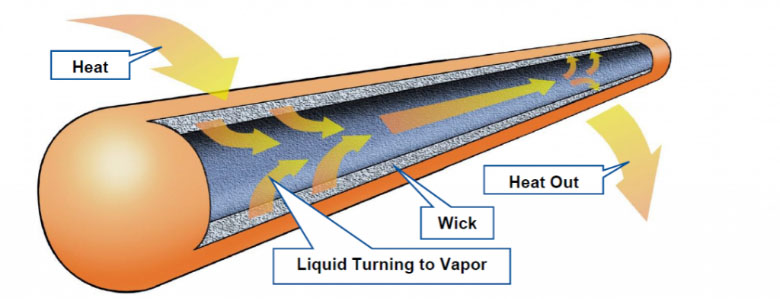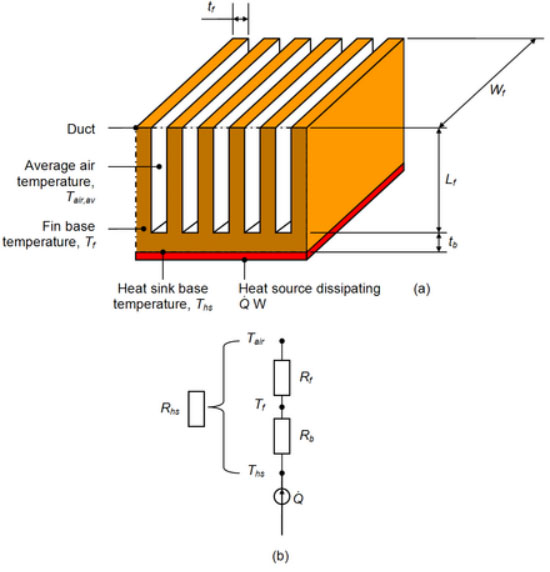
What is a Heat Pipe?
A heat pipe is a system for thermal transmission that may move heat and energy much faster than traditional techniques. A vaporizer liquid is poured into a circular tube to create the best heat pipe. The manufacturer makes a heat pipe with sealed construction with a thin coating of porous material lined interior surface, often known as a wick. It also includes a perfect heat pipe vapor space.

What is Heat Sink?
A heat sink is a kind of electrical device often connected to another electrical appliance to remove excess heat and is created out of a substance that is excellent at transferring heat. To avoid overheating and early system failures, you can use it to dissipate excess heat from the resistors and capacitors, increasing the devices' durability and effectiveness.
Research before investing in a hardware heat pipe or heat sink is usually a good idea. This blog explains everything you need to know about the differences between a heat pipe and a heat sink. Read on for more.
Main Difference Between A Heat Sink and a Heat Pipe?
Heat pipes and heat sinks are two different concepts. You can use these several variables to help you make a decision.
The most effective method to transfer heat or thermal capacity from one place to another is through the best heat pipe. Therefore it is something to keep in mind while making a comparison.
Space, medical, and military supplies cooling, as well as aviation refrigeration, is only the beginning of the many applications for heat pipes.
On the other hand, a high-quality heat sink is a standard conditioning solution that improves the area and airflow to remove heat from the device into the air surrounding it.
The purpose of this procedure is to prevent the device from overheating. Heat sinks with built-in fans are an easy, portable, and self-sufficient cooling method.
You can also differentiate between the two on the basis of how both of these systems work. The working principle of them is explained as under:
Working Of Heat Sink
Heat sinks operate by soaking up the heat generated by the associated components, such as a CPU. A rectangular or boxy metallic element should cover your computer's CPU if you remove the case and look at it from the front. You'll need a heat sink like this one to keep your computer running cool.
A heat sink is a structure that dissipates heat from electronic equipment. A larger device's surface area is one method by which this is accomplished. A high-quality heat sink's ability to transmit heat requires it to be hotter than its surroundings.
The high speeds at which current computers or other devices operate would be impossible without heat sinks.

If you don't know much about technology, assume the heat sink is like the cooling system in your car. A heat sink dissipates excess heat from your device, much as a radiator does for an automobile's engine.
It is equipped with a thermal conductor to cool down the heat sink and the processing. That transfers the heat from your device to the fins.
The high-quality heat sink, also known as a heat spreader, often has fins that resemble radiators. A fan is used to dissipate the heat generated by the device's internal components. Above the heat sink, a fan is mounted. The fan is reversed, which means it pulls the hot air out of the gadget.
Working Process Of Heat Pipe
The working principle of a heat pipe is quite different from the heat sink. However, both the systems aim to disperse heat for the sake of the efficient functioning of your device.
Using the high decomposition heat of a liquid, Heat Pipes are passively two-phase heat transmission devices that are entirely covered. It may work either through natural convection or a forced convection process.
To make a variable conductance heat pipe function, the fluid must head in one region, where it will transform to vapour. Because the whole container is vacuum-sealed, this process switching frequency occurs at temperatures below the accessible vapour point of the fluid.
Though they freeze at zero degrees Celsius, sintering copper hydronic pipes don't reach their optimal operating temperature until closer to twenty-five. Then, the vapour travels to a lower pressure region (far from the heating element) to chill and condense into a liquid.
Lastly, the fluid as thermal interface material is redirected to the condenser region by simply diffusion after soaking into the heat pipe wicking material.
If you soak just one edge of clean cloth in water, the whole cloth will eventually get drenched; so it is with the wick in a heat pipe. If you keep applying heat, the cycle will keep going.
Variable conductance heat pipes' diameter may range from 2mm to 12mm. As a general rule, the greater the circumference, the greater the heat capacity (in watts). It is conditional on the heat exchange wick material, the required operating angle, the amount of bending or flattening, and the operating speed and altitude.
Heat pipes can be:
●Flat heat pipes
●Loop heat pipe
●Oscillating heat pipe
●Rotating heat pipes
Why Are Heat Pipes Not Heat Sinks?
Heat pipes are inefficient at dispersing heat when used as a single container. In other words, they do not serve as heat sinks at all. They do not have sufficient area across their surfaces. Instead, these devices transfer heat from the thermal supply to the heat sink's fins. As a result, they are a component of an assembly for a high-quality heat sink.
Many manufacturers in China produce these gadgets to keep the temperature down of devices. Furthermore, If you use a COB LED in a light fixture, you will require a heat sink. Passively aluminum heat sinks are the typical method of transporting heat from the illumination source.
Does Heat Pipe & Heat Sink Work Together?
You may have a question in your mind about whether the constant conductance heat pipes and heat sink can work together or not. The answer to that question is yes! These are designed to function in tandem on various devices.
To begin, it is necessary to understand the relationship between the best standard heat pipe and high-quality heat sinks.
Your heat pipe technology and heat sink both have a solid object that is heat resistant and uses a volatile liquid in conjunction with each other. The fluid contained moves to the cold part of the heat pipe and sinks, and the condensing process occurs there.
At this stage, the liquid is brought back to the generous portion by gravity, centrifugal force, or hydraulic conductivity, depending on the specific mechanism. This process is mainly because boiling and condensing both have much more significant heat transfer efficiencies.
Heat sinks and heat pipes are well-known for their efficiency as thermal conductors, as is common knowledge.
The length of the heat pipe and the distance between the heat sink both affect the thermal conductivity of your system. This act demonstrates how effectively a heat pipe and heat sink can work together to transfer heat.
This set of gadgets that function together is also created in China by many experienced manufacturers, and it is designed to prevent heat from devices more perfectly.
Conclusion
Using a heat pipe or a heat sink is a proven method for removing heat from your equipment. Knowing the distinction is essential. Always choose the correct manufacturer. Don't worry about looking for a trustworthy manufacturer for your heat pipes and sinks. We have a long history of producing the best heat pipe and high-quality heat sinks. Get a quotation from us right now by Contacting Us.


 +86-18902844286
+86-18902844286
 E-mail
E-mail
